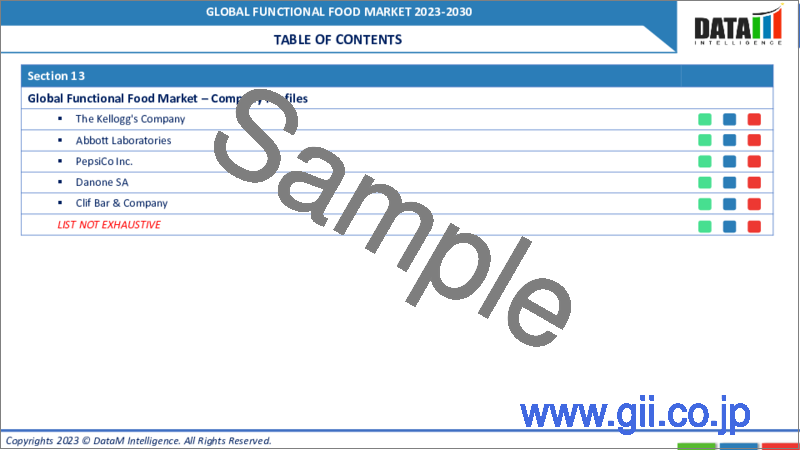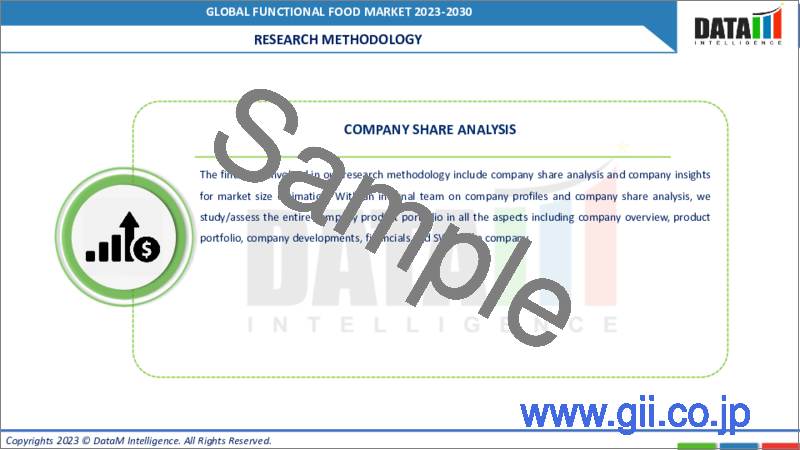|
|
市場調査レポート
商品コード
1304452
機能性食品の世界市場-2023年~2030年Global Functional Food Market - 2023-2030 |
||||||
|
● お客様のご希望に応じて、既存データの加工や未掲載情報(例:国別セグメント)の追加などの対応が可能です。 詳細はお問い合わせください。 |
|||||||
| 機能性食品の世界市場-2023年~2030年 |
|
出版日: 2023年07月07日
発行: DataM Intelligence
ページ情報: 英文 122 Pages
納期: 約2営業日
|
- 全表示
- 概要
- 目次
市場概要
世界の機能性食品市場は、2022年に1,954億米ドルに達し、2023~2030年の予測期間中にCAGR 6.2%で成長し、2030年には3,161億米ドルに達すると予測されています。
機能性食品市場の大きなチャンスの1つは、特定の健康上の懸念に対処し、多様な消費者ニーズをターゲットにする可能性です。機能性食品は、心血管系の健康のサポート、免疫力の向上、消化の改善、体重管理の促進、栄養欠乏への対応など、的を絞った健康上の利点を提供するよう処方することができます。機能性食品業界の顕著な動向のひとつは、植物由来の持続可能な選択肢に対する需要の高まりです。
栄養補助食品を機能性食品に統合することで、消費者は毎日の食生活に有益な化合物を便利かつ簡単に取り入れることができます。これは、特定の健康増進栄養素を摂取するためのより実用的で楽しいアプローチを提供することで、従来のサプリメント摂取に代わる選択肢を提供するものです。食物繊維強化食品は、食物繊維を取り入れることでその他の健康特典を提供する機能性食品の代表例です。食物繊維は植物性食品に含まれる炭水化物の一種で、人体では完全に消化されないです。食物繊維は食品に添加されると、様々な機能的・生理的効果をもたらします。
市場力学
栄養強化食品の消費の増加が機能性食品市場を牽引
栄養強化食品によって、消費者は特定の健康上の懸念に的を絞ったり、特定の食事要件を満たすことができます。例えば、栄養強化食品は鉄分、カルシウム、ビタミンD、またはオメガ 3系脂肪酸の欠乏に対処することができ、妊婦、アスリート、または特定の病状のある個人など、特定の集団のニーズに応えることができます。高齢化社会では、健康と活力の維持に一層の関心が集まっています。
健康的な加齢、認知機能、骨の健康、免疫機能をサポートする機能性食品は、この層からますます求められています。世界では2030年までに6人に1人が60歳以上になるといわれています。その頃には60歳以上の人口は14億人となり、2020年の10億人から増加します。世界の60歳以上の人口は、2050年までに2倍(21億人)に増加します。2020年から2050年にかけて、80歳以上の人口は4億2,600万人に達すると予測されています。
食品・飲料メーカーは栄養添加物の強化に取り組んでおり、これが機能性食品市場の成長を牽引
食品・飲料メーカーが栄養添加物の強化を自社製品に取り入れる傾向が強まっており、これが機能性食品市場の成長を牽引しています。この動向には、栄養の重要性に対する消費者の意識の高まりや、その他の健康特典を提供する製品に対する需要の高まりなど、いくつかの要因があります。必須ビタミン、ミネラル、抗酸化物質、その他の生物活性化合物を食品に強化することで、メーカーは製品の栄養プロファイルを強化し、健康志向の消費者の進化するニーズに応えることができます。
栄養機能食品製品の発売の増加は、市場の成長を後押しします。例えば、2022年11月02日、食品・飲料メーカーのGenoは、新しい機能性成分Avela natural (R)-1,3-Butanediolを発売し、機能性食品・飲料市場に参入しました。ラスベガスで開催されるSupplySide West 2022で一般初公開されるこの革新的な無糖製品は、ケトーシス時に体内で生成される主なエネルギー源であるβ-ヒドロキシ酪酸(BHB)ケトンレベルを高めるための、迅速、簡単、便利なソリューションを提供します。
機能性食品の高コストが市場の成長を妨げる
機能性食品は多くの場合、特殊な処方、成分、生産工程を必要とするため、その生産コストが高くなる可能性があります。こうした高いコストは消費者に転嫁されるため、機能性食品は従来の食品に比べて相対的に高価になります。その結果、消費者の価格感応度が障壁となり、機能性食品の広範な採用と入手が制限されることになります。
機能性食品の価格が高いことは、価格に敏感な消費者がこうした製品を定期的に食生活に取り入れることを躊躇させる可能性があります。また、付加的な利点のために割高な料金を支払うことを厭わない健康志向の高い個人というニッチなセグメントに市場が限定される可能性もあります。機能性食品と従来の代替品との間の手頃な価格のギャップは、市場浸透の遅れと潜在的な消費者層の限定につながる可能性があります。
COVID-19の影響
パンデミックは世界のサプライ・チェーンを混乱させ、機能性食品を含む様々な食品の入手可能性と流通に影響を及ぼしました。この混乱は、機能性原料の調達および製造工程における課題につながり、その結果、潜在的な供給不足または供給遅れが生じる。小売店の閉鎖や対面での買い物の制限により、食品のオンライン販売の成長が加速しています。機能性食品企業は、eコマース機能を拡大し、オンライン・マーケティングと販売チャネルに注力することで適応せざるを得なくなっています。
パンデミックは、機能性食品分野における新製品の発売とイノベーションに課題を突き付けた。対面式のイベントや集会が制限されたことで、製品の展示、試食、消費者との交流の機会が制限されました。パンデミックは、機能性食品に関連する研究開発活動にも影響を及ぼしています。臨床試験や研究は、被験者や研究室への立ち入りが制限されたために遅延したり中断したりした可能性があります。このことは、市場における新たな機能性食品素材および製剤のイントロダクション影響を及ぼす可能性があります。パンデミックの経済的影響は、消費者の購買力や裁量支出に影響を及ぼしています。一部の消費者は価格に敏感になって、機能性食品よりも必需品の食品を優先するようになり、購買パターンが変化する可能性があります。
ロシア・ウクライナ影響分析
政治的緊張は、食品安全規制や表示要件を含む規制環境の変化につながる可能性があります。機能性食品業界で事業を展開する企業は、製品の処方、ラベリング、およびコンプライアンス・プロセスに影響を及ぼす新規の規制や変更された規制を通過する必要があります。政治的緊張は、相手国の製品に対する消費者の認識や信頼に影響を与えます。否定的な感情や偏見が消費者の選択に影響を及ぼし、他国原産の機能性食品に対する需要の減少につながる可能性があります。これは、市場での存在感を確立または維持しようとする企業にとって難題となりうる。
政治的緊張も、機能性食品の分野におけるロシアとウクライナの間の協力と研究の機会を妨げています。共同研究プロジェクト、知識の共有、およびパートナーシップは、課題や遅れに直面する可能性があり、両国の機能性食品科学とイノベーションの進展に影響を及ぼします。
目次
第1章 調査手法と調査範囲
第2章 定義と概要
第3章 エグゼクティブサマリー
第4章 市場力学
- 影響要因
- 促進要因
- 栄養強化食品の消費増加が機能性食品市場を牽引
- 食品・飲料メーカーによる栄養添加物の強化が機能性食品市場の成長を促進
- 抑制要因
- 機能性食品の高コストが市場の成長を妨げ
- 機会
- 影響分析
- 促進要因
第5章 産業分析
- ポーターのファイブフォース分析
- サプライチェーン分析
- 価格分析
- 規制分析
第6章 COVID-19分析
第7章 成分別
- プロバイオティクス
- ミネラル
- タンパク質・アミノ酸
- プレバイオティクス・食物繊維
- ビタミン
- その他
第8章 製品別
- ベーカリー・シリアル
- 乳製品
- 肉類
- 魚・卵
- 大豆製品
- 油脂
- その他
第9章 用途別
- スポーツ栄養
- 体重管理
- 臨床栄養
- 心臓の健康
- その他
第10章 地域別
- 北米
- 米国
- カナダ
- メキシコ
- 欧州
- ドイツ
- 英国
- フランス
- イタリア
- スペイン
- その他欧州
- 南米
- ブラジル
- アルゼンチン
- その他南米
- アジア太平洋
- 中国
- インド
- 日本
- オーストラリア
- その他アジア太平洋地域
- 中東・アフリカ
第11章 競合情勢
- 競合シナリオ
- 市況/シェア分析
- M&A分析
第12章 企業プロファイル
- Lotus Bakeries
- 会社概要
- 製品ポートフォリオと説明
- 財務概要
- 主な発展
- Nestle S.A.
- Hearthside Food Solutions LLC
- Valio Eesti AS
- The Kellogg's Company
- Abbott Laboratories
- PepsiCo Inc.
- Danone SA
- Clif Bar & Company
- General Mills
第13章 付録
Market Overview
The Global Functional Food Market reached US$ 195.4 billion in 2022 and is expected to reach US$ 316.1 billion by 2030 growing with a CAGR of 6.2% during the forecast period 2023-2030.
One significant opportunity of the functional food market is the potential to address specific health concerns and target diverse consumer needs. Functional foods can be formulated to provide targeted health benefits, such as supporting cardiovascular health, boosting immunity, improving digestion, promoting weight management, or addressing nutritional deficiencies. One prominent trend in the functional food industry is the growing demand for plant-based and sustainable options.
The integration of nutraceuticals into functional food allows consumers to conveniently and easily incorporate beneficial compounds into their everyday diets. It provides an alternative to traditional supplement consumption by offering a more practical and enjoyable approach to obtaining specific health-enhancing nutrients. Fiber enriched foods are a prime example of functional food that offers additional health benefits through the incorporation of dietary fiber. Dietary fiber is a type of carbohydrate found in plant-based foods that cannot be fully digested by the human body. When added to food products, fiber provides various functional and physiological effects.
Market Dynamics
Increasing Consumption of Nutrient-enriched Food Drives Functional Foods Market
Nutrient-enriched foods allow consumers to target specific health concerns or meet specific dietary requirements. For example, fortified foods can address deficiencies in iron, calcium, vitamin D, or omega-3 fatty acids, catering to the needs of specific populations such as pregnant women, athletes, or individuals with specific medical conditions. The aging population is more concerned about maintaining their health and vitality.
Functional foods that support healthy aging, cognitive function, bone health, and immune function are increasingly sought after by this demographic. One in six individuals on the globe will be 60 or older by 2030. By this time, there will be 1.4 billion people over the age of 60, up from 1 billion in 2020. The number of individuals in the world aged 60 or older will double (to 2.1 billion) by 2050. Between 2020 and 2050, the number of people 80 or older is projected to reaching 426 million.
Food and Beverage Manufacturers are Deploying Fortification of Nutritional Additives Which Drives Functional Food Market Growth
Food and beverage manufacturers are increasingly incorporating fortification of nutritional additives into their products, driving the growth of the functional food market. This trend is fueled by several factors, including rising consumer awareness of the importance of nutrition and a growing demand for products that offer additional health benefits. Fortifying food with essential vitamins, minerals, antioxidants, and other bioactive compounds allows manufacturers to enhance the nutritional profile of their products and meet the evolving needs of health-conscious consumers.
The increase in the nutritional functional food product launches helps to boost the market growth. For instance, on November 02, 2022, Geno, a food and beverage manufacturer entered into the functional foods and beverages market with the launch of new functional ingredient, Avela natural (R)-1,3-Butanediol. The innovative, sugar-free product, which will make its public premiere at SupplySide West 2022 in Las Vegas, provides a quick, simple, and convenient solution to increase levels of beta-hydroxybutyrate (BHB) ketone, the main energy source produced in the body during ketosis.
High Cost of the Functional Food Hampers Market Growth
Functional foods often require specialized formulations, ingredients, and production processes, which can increase their production costs. These higher costs are passed on to consumers, making functional foods relatively more expensive compared to conventional food products. As a result, price sensitivity among consumers becomes a barrier, limiting the broader adoption and accessibility of functional foods.
The high cost of functional food can deter price-conscious consumers from regularly incorporating these products into their diets. It may also restrict the market to a niche segment of health-conscious individuals who are willing to pay a premium for the added benefits. The affordability gap between functional foods and conventional alternatives can lead to a slower market penetration and limit the potential consumer base.
COVID-19 Impact
The pandemic has disrupted global supply chains, impacting the availability and distribution of various food products, including functional foods. This disruption has led to challenges in sourcing functional ingredients and manufacturing processes, resulting in potential supply shortages or delays. The closure of retail outlets and restrictions on in-person shopping have accelerated the growth of online food sales. Functional food companies have had to adapt by expanding their e-commerce capabilities and focusing on online marketing and sales channels.
The pandemic has posed challenges for new product launches and innovation in the functional food sector. Restrictions on in-person events and gatherings have limited opportunities for product showcases, tastings, and consumer engagement. The pandemic has affected research and development activities related to functional foods. Clinical trials and studies may have been delayed or disrupted due to restrictions on human subjects and laboratory access. This could impact the introduction of new functional food ingredients and formulations in the market. The economic impact of the pandemic has affected consumer purchasing power and discretionary spending. Some consumers may be more price-conscious and prioritize essential food items over functional foods, leading to potential shifts in buying patterns.
Russia-Ukraine Impact Analysis
Political tensions potentially lead to changes in regulatory environments, including food safety regulations and labeling requirements. Companies operating in the functional food industry need to navigate through new or modified regulations, which impact their product formulations, labeling, and compliance processes. Political tensions impacted consumer perceptions and confidence in products from the opposing country. Negative sentiments or biases may influence consumer choices, leading to a decline in the demand for functional food products originating from other country. This can create challenges for companies trying to establish or maintain a strong market presence.
Political tensions also hamper collaboration and research opportunities between Russia and Ukraine in the field of functional foods. Joint research projects, knowledge sharing, and partnerships may face challenges or delays, impacting the advancement of functional food science and innovation in both countries.
Segment Analysis
The global functional food market is segmented based on ingredient, product, application, and region.
Increased Demand for Prebiotics & Dietary Fibers Ingredients in Food and Beverage Industry Drives Segment Growth
The global functional food market by ingredient has been segmented by probiotics, minerals, proteins & amino acids, prebiotics & dietary fibers, vitamins and others.
Prebiotics and dietary fibers are key ingredients often incorporated into functional foods due to their significant health benefits. Prebiotics are non-digestible fibers that selectively stimulate the growth and activity of beneficial bacteria in the gut, promoting a healthy gut microbiome. Dietary fibers, on the other hand, include a range of plant-based carbohydrates that are not digested by human enzymes but provide important physiological effects.
Prebiotics and dietary fibers act as nourishment for beneficial gut bacteria, promoting their growth and activity. They help maintain a healthy balance of gut microbiota, which plays a crucial role in digestive health, immune function, and overall well-being. An increase in the new product launches with the cream filled wafers helps to boost segment growth over the forecast period. In October 2021, OptiBiotix Health PLC launched SnackSmart Fruit & Fibre gummies. It promotes a healthy gut via a blend of non-digestible prebiotics and dietary fiber glucomannan, and chromium.
Geographical Analysis
The Increased Demand for Functional Food in North America
The United States and Canada are major share-holding countries in the region due to increasing demand for functional food from health-conscious consumers. The United States has a large population that is increasingly focused on health and wellness. Consumers are actively seeking out food products that offer additional nutritional benefits and functional properties. Canadian food manufacturers are investing in research and development to enhance the nutritional profiles and functional properties of their products.
Canadian consumers are increasingly concerned about the environmental and ethical aspects of their food choices Also, an increase in the merger, acquisition and partnership strategies in the region drives market growth. For instance, on November 17, 2022, An broad line of plant-based seafood substitutes will be developed through a new partnership between Canadian companies Konscious Foods, Merit Functional Foods, and Canadian Pacifico Seaweeds.
Competitive Landscape
The major global players include Lotus Bakeries, Nestle S.A., Hearthside Food Solutions LLC, Valio Eesti AS, The Kellogg's Company, Abbott Laboratories, PepsiCo Inc., Danone SA, Clif Bar & Company and General Mills.include:
Why Purchase the Report?
- To visualize the global functional food market segmentation based on ingredient, product, application, and region, as well as understand key commercial assets and players.
- Identify commercial opportunities by analyzing trends and co-development.
- Excel data sheet with numerous data points of functional food market-level with all segments.
- PDF report consists of a comprehensive analysis after exhaustive qualitative interviews and an in-depth study.
- Product mapping available as Excel consisting of key products of all the major players.
The global functional food market report would provide approximately 63 tables, 65 figures and 122 Pages.
Target Audience 2023
- Manufacturers/ Buyers
- Industry Investors/Investment Bankers
- Research Professionals
- Emerging Companies
Table of Contents
1. Methodology and Scope
- 1.1. Research Methodology
- 1.2. Research Objective and Scope of the Report
2. Definition and Overview
3. Executive Summary
- 3.1. Snippet by Ingredient
- 3.2. Snippet by Product
- 3.3. Snippet by Application
- 3.4. Snippet by Region
4. Dynamics
- 4.1. Impacting Factors
- 4.1.1. Drivers
- 4.1.1.1. Increasing Consumption of Nutrient-enriched Food Drives Functional Foods Market
- 4.1.1.2. Food and Beverage Manufacturers are Deploying Fortification of Nutritional Additives Which Drives Functional Food Market Growth
- 4.1.2. Restraints
- 4.1.2.1. High Cost of the Functional Food Hampers Market Growth
- 4.1.3. Opportunity
- 4.1.4. Impact Analysis
- 4.1.1. Drivers
5. Industry Analysis
- 5.1. Porter's Five Force Analysis
- 5.2. Supply Chain Analysis
- 5.3. Pricing Analysis
- 5.4. Regulatory Analysis
6. COVID-19 Analysis
- 6.1. Analysis of COVID-19
- 6.1.1. Scenario Before Covid-19
- 6.1.2. Scenario During Covid-19
- 6.1.3. Scenario Pos tCOVID-19
- 6.2. Pricing Dynamics Amid COVID-19
- 6.3. Demand-Supply Spectrum
- 6.4. Government Initiatives Related to the Market During Pandemic
- 6.5. Manufacturers Strategic Initiatives
- 6.6. Conclusion
7. By Ingredient
- 7.1. Introduction
- 7.1.1. Market Size Analysis and Y-o-Y Growth Analysis (%), By Ingredient
- 7.1.2. Market Attractiveness Index, By Ingredient
- 7.2. Probiotics *
- 7.2.1. Introduction
- 7.2.2. Market Size Analysis and Y-o-Y Growth Analysis (%)
- 7.3. Minerals
- 7.4. Proteins & Amino Acids
- 7.5. Prebiotics & Dietary Fibers
- 7.6. Vitamins
- 7.7. Others
8. By Product
- 8.1. Introduction
- 8.1.1. Market Size Analysis and Y-o-Y Growth Analysis (%), By Product
- 8.1.2. Market Attractiveness Index, By Product
- 8.2. Bakery & Cereals *
- 8.2.1. Introduction
- 8.2.2. Market Size Analysis and Y-o-Y Growth Analysis (%)
- 8.3. Dairy Products
- 8.4. Meat
- 8.5. Fish & Eggs
- 8.6. Soy Products
- 8.7. Fats & Oils
- 8.8. Others
9. By Application
- 9.1. Introduction
- 9.1.1. Market Size Analysis and Y-o-Y Growth Analysis (%), By Application
- 9.1.2. Market Attractiveness Index, By Application
- 9.2. Sports Nutrition *
- 9.2.1. Introduction
- 9.2.2. Market Size Analysis and Y-o-Y Growth Analysis (%)
- 9.3. Weight Management
- 9.4. Clinical Nutrition
- 9.5. Cardio Health
- 9.6. Others
10. By Region
- 10.1. Introduction
- 10.1.1. Market Size Analysis and Y-o-Y Growth Analysis (%), By Region
- 10.1.2. Market Attractiveness Index, By Region
- 10.2. North America
- 10.2.1. Introduction
- 10.2.2. Key Region-Specific Dynamics
- 10.2.3. Market Size Analysis and Y-o-Y Growth Analysis (%), By Ingredient
- 10.2.4. Market Size Analysis and Y-o-Y Growth Analysis (%), By Product
- 10.2.5. Market Size Analysis and Y-o-Y Growth Analysis (%), By Application
- 10.2.6. Market Size Analysis and Y-o-Y Growth Analysis (%), By Country
- 10.2.6.1. The U.S.
- 10.2.6.2. Canada
- 10.2.6.3. Mexico
- 10.3. Europe
- 10.3.1. Introduction
- 10.3.2. Key Region-Specific Dynamics
- 10.3.3. Market Size Analysis and Y-o-Y Growth Analysis (%), By Ingredient
- 10.3.4. Market Size Analysis and Y-o-Y Growth Analysis (%), By Product
- 10.3.5. Market Size Analysis and Y-o-Y Growth Analysis (%), By Application
- 10.3.6. Market Size Analysis and Y-o-Y Growth Analysis (%), By Country
- 10.3.6.1. Germany
- 10.3.6.2. The U.K.
- 10.3.6.3. France
- 10.3.6.4. Italy
- 10.3.6.5. Spain
- 10.3.6.6. Rest of Europe
- 10.4. South America
- 10.4.1. Introduction
- 10.4.2. Key Region-Specific Dynamics
- 10.4.3. Market Size Analysis and Y-o-Y Growth Analysis (%), By Ingredient
- 10.4.4. Market Size Analysis and Y-o-Y Growth Analysis (%), By Product
- 10.4.5. Market Size Analysis and Y-o-Y Growth Analysis (%), By Application
- 10.4.6. Market Size Analysis and Y-o-Y Growth Analysis (%), By Country
- 10.4.6.1. Brazil
- 10.4.6.2. Argentina
- 10.4.6.3. Rest of South America
- 10.5. Asia-Pacific
- 10.5.1. Introduction
- 10.5.2. Key Region-Specific Dynamics
- 10.5.3. Market Size Analysis and Y-o-Y Growth Analysis (%), By Ingredient
- 10.5.4. Market Size Analysis and Y-o-Y Growth Analysis (%), By Product
- 10.5.5. Market Size Analysis and Y-o-Y Growth Analysis (%), By Application
- 10.5.6. Market Size Analysis and Y-o-Y Growth Analysis (%), By Country
- 10.5.6.1. China
- 10.5.6.2. India
- 10.5.6.3. Japan
- 10.5.6.4. Australia
- 10.5.6.5. Rest of Asia-Pacific
- 10.6. Middle East and Africa
- 10.6.1. Introduction
- 10.6.2. Key Region-Specific Dynamics
- 10.6.3. Market Size Analysis and Y-o-Y Growth Analysis (%), By Ingredient
- 10.6.4. Market Size Analysis and Y-o-Y Growth Analysis (%), By Product
- 10.6.5. Market Size Analysis and Y-o-Y Growth Analysis (%), By Application
11. Competitive Landscape
- 11.1. Competitive Scenario
- 11.2. Market Positioning/Share Analysis
- 11.3. Mergers and Acquisitions Analysis
12. Company Profiles
- 12.1. Lotus Bakeries*
- 12.1.1. Company Overview
- 12.1.2. Product Portfolio and Description
- 12.1.3. Financial Overview
- 12.1.4. Key Developments
- 12.2. Nestle S.A.
- 12.3. Hearthside Food Solutions LLC
- 12.4. Valio Eesti AS
- 12.5. The Kellogg's Company
- 12.6. Abbott Laboratories
- 12.7. PepsiCo Inc.
- 12.8. Danone SA
- 12.9. Clif Bar & Company
- 12.10. General Mills
LIST NOT EXHAUSTIVE
13. Appendix
- 13.1. About Us and Services
- 13.2. Contact Us




